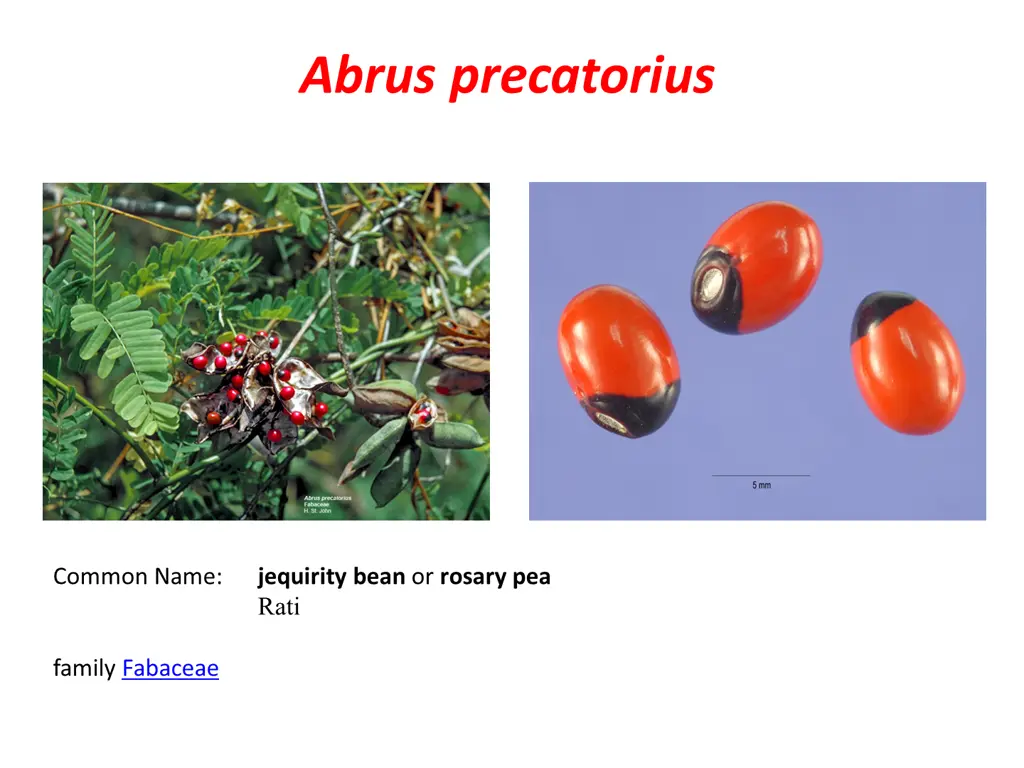Abrus precatorius
Abrus Precatorius, also known as the jequirity bean or rosary pea, is a highly toxic plant that is found throughout the tropics. Its seeds are used in jewelry and necklaces, but they can be fatal if ingested. This article explores the distribution, toxic principle, animals affected, mechanism of toxicity, and clinical signs of abrin poisoning.
Download Presentation

Please find below an Image/Link to download the presentation.
The content on the website is provided AS IS for your information and personal use only. It may not be sold, licensed, or shared on other websites without obtaining consent from the author.If you encounter any issues during the download, it is possible that the publisher has removed the file from their server.
You are allowed to download the files provided on this website for personal or commercial use, subject to the condition that they are used lawfully. All files are the property of their respective owners.
The content on the website is provided AS IS for your information and personal use only. It may not be sold, licensed, or shared on other websites without obtaining consent from the author.
E N D
Presentation Transcript
Abrus precatorius Common Name: family Fabaceae jequirity bean or rosary pea Rati
Distribution Throughout the tropics Twinning perennial vine with yellow or red flowers Seeds are used as beads in jewellery and necklace Toxic part Seeds: used for malicious poisoning and rarely homicide Whole seeds have no toxic effects to cattle but toxic to fowls (die with in few days) Powdered seeds toxic by mouth to all species Broken seeds are highly toxic (one seed can kill a small child or medium sized dog)
Toxic principle: Abrin is an extremely toxic toxalbumin found in the seeds. Median lethal dose : Mice: of 0.7 g/kg body mass (intravenously) Approximately 31.4 times more toxic than ricin. Humans: 10 to 1000 g/kg body mass (ingested) 3.3 g/kg body mass (inhaled) Horses: Sixty gram powdered seeds can kill Cattle and goat are more resistant by oral administration (Parentral decorticated seeds i.e. 0.6 mg/kg) fatal to cattle Ingestion of a single seed, well chewed, can be fatal to both adults and children
Animals affected: All species of animals. Cattle are generally poisoned for revenge by leather workers to obtain the hides cheaply. (Malicious poisoning) Ecology tropical regions, so much so that it has become effectively pantropical in distribution Abrus precatorius is a severely invasive plant in warm temperate to
Mechanism of Toxicity Abrin (Toxalbumin/phytoprotein) Not affected by gastric juices Potent cytotoxin Abrin a type 2 ribosome-inactivating protein The toxic effect of abrin is due to an intracellular, multi-step process by binding to and penetrating the cells of the body, inhibiting cell protein synthesis after being transported to the endoplasmic reticulum (ER). Binds with 28S rRNA of the large ribosomal subunit of a ribosome on or near the ER, inhibiting the regular process of cellular protein synthesis. Causes agglutination of red blood cells Abrin probably, because of peculiar binding potential is selectively transported (suicide transport) by the neurons
Clinical Signs The major symptoms of abrin poisoning depend on the route of exposure and the dose received. In general, symptoms can appear anywhere between several hours to several days after exposure. Initial symptoms of abrin poisoning by inhalation may occur within 8 h of exposure but a more typical time course is 18 24 hours; Fatal within 36 72 hours. Following ingestion of abrin, initial symptoms usually occur rapidly, but can take up to five days to appear. The later signs and symptoms of exposure are caused by abrin's cytotoxic effects, killing cells in the kidney, liver, adrenal glands, and central nervous system
Salivation Nasal discharge Nausea Vomition Profuse hemorrhagic diarrhoea Watery feces Ulcerative lesions in mouth and oesophagus Painful swelling around area of implant Enlargement of regional lymph nodes Increased body temperature Stiffness of muscle Incoordination Ataxia Muscular spasms Trembling Convulsions Paralysis Coma Death
Post Mortem Lesions 1) Acute gastroenteritis with mucosal and serosal gastric hemorrhages 2) Accumulation of fluid in the lumen of intestine 3) Petechial hemorrhages throughout body 4) Hepatic and renal necrosis
Diagnosis History & circumstantial evidences Clinical Signs PM Examination Treatment Symptomatic and supportive Removal of poison from GIT by emesis or lavaging Followed by activated charcoal, demulscents and saline purgatives Intravenous infusion of fluids and electrolytes
Ricinus Communis castor-oil plant, (Ricinus communis), also called castor bean family (Euphorbiaceae) Probably native to tropical Africa, the castor-oil plant has become naturalized throughout warm areas of the world Cultivated in India and other temperate regions The plants are chiefly cultivated in India, China, and Brazil, largely as the source of castor oil.
Grown commercially for the pharmaceutical and industrial uses of its oil and for use in landscaping. Although the plant is the only species in its genus, there are hundreds of natural forms and many horticultural varieties. The oil-rich seeds contain the poison ricin, one of the most toxic substances known, and consumption of chewed seeds can be lethal.
Ricin, discovered in 1888 by German scientist Peter Hermann Stillmark, is one of the most toxic substances known. It is of special concern because of its potential use as a biological weapon. Accidental exposure to ricin is rare and results primarily from the ingestion of castor seeds. In the tropics the plants reach about 10 to 13 metres (30 to 40 feet) in height. In temperate climates they are raised as annuals and grow 1.5 to 2.5 metres (4.9 to 8 feet) in a single season. The plants bear handsome giant 12-lobed palmate (fanlike) leaves. The bristly spined bronze-to-red clusters of fruits are attractive but often are removed before they mature, because of the ricin concentrated in their mottled beanlike seeds.
It is used in the production of synthetic resins, plastics, fibres, paints, varnishes, and various chemicals including drying oils and plasticizers. Castor oil is viscous, has a clear and colourless to amber or greenish appearance, a faint characteristic odour, and a bland but slightly acrid taste, with a usually nauseating aftertaste. Castor oil is obtained from castor beans either by pressing or by solvent extraction. Both beans and oil are produced principally by India and Brazil and consumed primarily in the United States, largely in industry. Residual cake contains: Ricin-I and Ricin-II (Toxic Principle/phytotoxin) 1g seed gives 1mg pure toxin
In addition to the uses mentioned previously, castor oil and its derivatives are used in cosmetics, hair oils, fungistatic (fungus-growth-inhibiting) compounds, embalming fluid, printing inks, soap, lubricants, greases and hydraulic fluids, dyeing aids, and textile finishing materials. Turkey-red oil, long used as a dyeing aid, is produced by the reaction of castor oil with sulfuric acid. Castor oil consists almost entirely of the triglycerides ricinoleic acid; and although castor oil has been taken internally as a cathartic, its use can be harmful.
Susceptible species: All species of animals Horses most susceptible (LD50 = 0.007g/kg) Dogs, sheep, cattle, goats and pigs comparatively resistant LD50 (g/kg) for other animals Species Seeds Oil cake Rabbit Sheep Pig Piglet Cattle Calf Goat Goose Hen Dog 1.00 1.25 1.30 2.40 2.00 0.50 5.50 0.40 14.00 0.6-5.00 2.00 2.50 5.00-6.00 -- 3.00 -- -- -- 40.00 3.50
Mechanism of Toxicity Induce hydrolytic fragmentation of ribosomes Inhibit protein synthesis Chain A of Ricin inactivates 60s ribosomal subunit inhibit protein synthesis- endocytosed in cell cytosol after chain B binds to a terminal galactose residue on cell membrane
Signs and Symptoms Purified ricin can enter the body through ingestion, inhalation, or injection. The early symptoms of poisoning following ingestion include diarrhea and vomiting, which can lead to dehydration. In cases of severe poisoning by ingestion, these symptoms are followed by seizures, hallucinations, and liver and renal failure, usually within 72 hours. If ricin poisoning occurs by inhalation, symptoms may include difficulty breathing, tightness in the chest, cough, and nausea. Severe poisoning by inhalation causes fluid accumulation in the lungs and respiratory failure, leading to death within 36 to 72 hours. When ricin is injected, it causes red blood cells to clump together (agglutination), which in turn leads to the destruction of red cells (hemolysis) and produces symptoms similar to poisoning by ingestion. Very small doses of ricin can be lethal if inhaled or injected, since these routes of exposure enable the toxin to immediately enter the bloodstream, resulting in its rapid distribution throughout the body.
Toxicology tests may be used to detect ricin in the blood or urine; however, these tests are generally impractical in an emergency situation, since they require more time than is available to confirm poisoning. In addition, there is no antidote available for ricin poisoning, and as a result treatment is supportive. If less than an hour has passed since ingestion, gastric lavage may be performed to remove the poison from the stomach. Intravenous fluids are administered to prevent dehydration, and activated charcoal may be given to absorb the poison from the gastrointestinal tract. In some cases, poisoned individuals recover.
Calotropis gigantea Calotropis gigantea, the crown flower, is a species of Calotropis native to Cambodia, Vietnam, Bangladesh, Indonesia, Malaysia, Thailand, Sri Lanka, India, China, Pakistan, and Nepal. It is a large shrub growing to 4 m (13 ft) tall. The aestivation found in calotropis is valvate i.e. sepals or petals in a whorl just touch one another at the margin, without overlapping. The plant has oval, light green leaves and milky stem. The latex of Calotropis gigantea contains cardiac glycosides, fatty acids, and calcium oxalate. The roots also contain Calotropone
This family includes Calotropis gigantea and the more potent Calotropis procera. The latex of these plants has been used in Africa as an arrow poison.
Medical uses Given the potent bioactivity of calotropin, calotropis gigantea has been used as a folk medicine in India for many years, and has been reported to have a variety of uses. In Ayurveda, Indian practitioners have used the root and leaf of C. procera in asthma and also used in bacterial infection, swelling with redness, boils also and shortness of breath and the bark in liver and spleen diseases. The treating skin, digestive, respiratory, circulatory and neurological disorders and was used to treat fevers, elephantiasis, nausea, vomiting, and diarrhea. plant is reported as effective in The milky juice of Calotropis procera was used against arthritis, cancer, and as an antidote for snake bite. However, these reports are of folk uses and more research is needed to confirm the clinical usefulness of the leaves, latex, and bark. Recent studies have displayed use of calotropin as a contraceptive and as a potential cancer medication.
Calotropis is a poisonous plant. The active principles are uscharin, calotoxin, calactin, and calotropin. The leaves and stem when incised yield thick milky juice. It is used as an arrow poison, cattle poison, rarely for suicide and homicide and mostly an accidental poison. The milky latex sap of Calotropis gigantea is a known cause of toxic keratoconjunctivitis and reversible vision loss. Crown flower keratitis is a rare condition and is usually the result of accidental ocular exposure to the sap. The condition is usually self-limited and resolves faster with topical steroids. The clinical course of this condition suggests that Calotropis is paradoxically relatively nontoxic to corneal epithelium and highly toxic to corneal endothelium.
Signs and symptoms Applied to the skin, it causes redness and vesication. When taken orally, the juice produces an acrid, bitter taste and burning pain in throat and stomach, salivation, stomatitis, vomiting, diarrhea, dilated pupils, tetanic convulsions, collapse and death. The fatal period is 6 to 12 hours. Treatment includes stomach wash, demulcents, and symptomatic treatment







